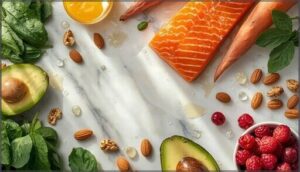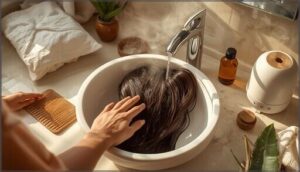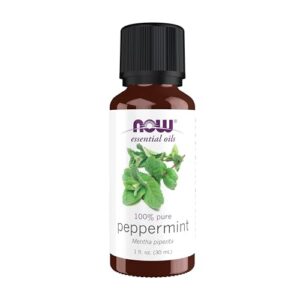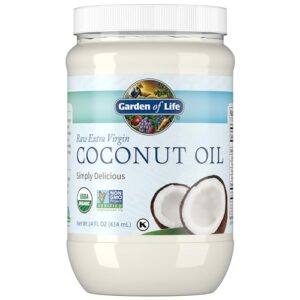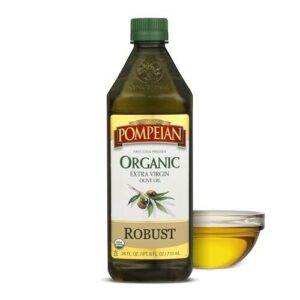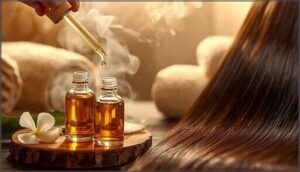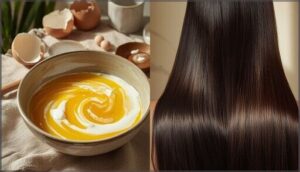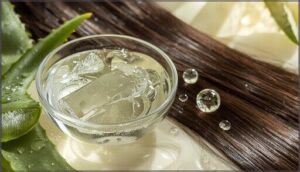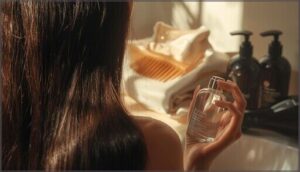This site is supported by our readers. We may earn a commission, at no cost to you, if you purchase through links.
Your hair’s moisture barrier breaks down faster than you might think. Sun exposure, heat styling, and even your daily shampoo strip away the natural oils that keep strands hydrated and resilient. Within weeks, what started as a minor dryness problem can turn into brittle, lifeless hair that resists every conditioner you throw at it.
The good news? You don’t need expensive treatments or salon visits to reverse the damage. Kitchen staples like coconut oil, avocado, and honey contain the exact compounds your hair needs to rebuild its structure and seal in moisture.
Understanding what causes dryness and how to treat it with home remedies puts you back in control of your hair’s health.
Table Of Contents
- Key Takeaways
- Common Causes of Dry Hair
- Essential Nutrients for Healthy Hair
- Daily Hair Care Tips for Dryness
- Top 5 Products for Dry Hair Relief
- DIY Home Remedies for Dry Hair
- Natural Oils and Butters for Moisture
- Preventing Dry Hair and Maintaining Results
- Frequently Asked Questions (FAQs)
- Does dry hair mean it’s damaged?
- Is a coffee rinse efficient in treating dry hair?
- How often should you wash your hair?
- Can banana masks be useful in treating hair dryness?
- Does dry hair cause hair loss?
- Can dry hair cause hair loss or thinning?
- How long until home remedies show results?
- Does hard water make hair more dry?
- Are silk pillowcases better for dry hair?
- Can stress or hormones cause dry hair?
- Conclusion
Key Takeaways
- Your hair’s moisture barrier breaks down through sun exposure, heat styling, and harsh products that strip natural oils, leading to brittle strands that resist conditioning—but kitchen staples like coconut oil, avocado, and honey contain compounds that rebuild structure and seal in hydration without expensive treatments.
- Dry hair stems from habits and environmental factors, including UV damage that raises porosity by 10-15%, chemical treatments that disrupt cuticles in 95% of cases, and overwashing that strips protective sebum—protection requires wearing hats, limiting heat tools, spacing chemical processes, and choosing sulfate-free products.
- Essential nutrients work from within to restore moisture: omega-3 fatty acids from fish and walnuts reduce shedding, protein and iron (ferritin) prevent follicle weakness and breakage, while vitamins A, D, E, and biotin produce natural oils and strengthen brittle strands when delivered through targeted foods or supplements.
- Weekly treatments with penetrating oils like coconut (reduces surface roughness by 30-65%) or shea butter masks, combined with protective habits like limiting heat to twice weekly below 185°C and trimming every 6-12 weeks, deliver measurable results within two weeks while preventing the structural damage that makes thinning worse over time.
Common Causes of Dry Hair
Your hair doesn’t become dry overnight—it’s usually the result of habits and environmental factors that strip away moisture over time. Understanding what’s behind the dryness gives you the power to stop the damage and restore your hair’s natural hydration.
Let’s look at the most common culprits that leave your strands parched and brittle.
Sun Exposure and Environmental Damage
Prolonged sun exposure and environmental stress strip your hair’s natural defenses. UV damage degrades cuticle proteins, raising hair porosity by 10–15% after several weeks, while pollutants slash tensile strength by 8–12%. Climate impact is real: humidity and dry air pull moisture out, leaving strands brittle.
Protect yourself:
- Wear hats during peak sun
- Choose sunscreen products for hair
- Rinse after pool or pollution exposure
Understanding the effects of environmental factors, such as exposure to systematic review processes, can help in developing effective hair care strategies.
Heat Styling and Overwashing
Heat styling tools evaporate internal water from your hair cortex, leaving fibers brittle and frizz-prone. Repeated exposure to even moderate heat triggers “heat fatigue”—hydrogen bonds break down, elasticity drops, and strands feel like straw.
Meanwhile, overwashing strips sebum and natural lipids, raising hair porosity and accelerating dryness.
Limit hot-tool use, lower your washing frequency, and always condition to lock in moisture and prevent further damage. Understanding the effects of heat styling tools is vital for maintaining healthy hair.
Chemical Treatments and Product Choices
Chemical processing—hair dye, relaxers, straightening treatments—disrupts your cuticle and spikes porosity, letting moisture escape. Clinical data show 95% of patients report dryness after color damage or chemical treatments. Sulfate effects compound the problem: harsh product ingredients strip natural oils your scalp produces for protection.
Before your next hair treatment, check labels. Swap sulfate-laden formulas for gentler alternatives that support hair health:
- Choose sulfate-free, moisturizing shampoos to preserve natural oils
- Avoid alcohol-based styling products that worsen dry hair
- Use shea-butter conditioners after any chemical processing
- Space out hair dye sessions to limit cumulative hair damage
- Read ingredient lists—skip formulas with drying agents
Poor Hair Care Habits
If you’re brushing too hard, shampooing daily, or skipping conditioner, you’re courting dry hair and breakage. Over-shampooing strips essential oils, while rough toweling chips away at your cuticle. Neglecting trims lets split ends run wild. Think of your hair care routine as a hydration ritual—each step, from gentle brushing to proper moisturizing, matters.
| Habit | Effect | Solution |
|---|---|---|
| Hair Brushing | Breakage | Use wide-tooth comb |
| Over Shampooing | Dry hair | Wash less often |
| Rough Toweling | Cuticle damage | Pat dry gently |
| Inadequate Conditioning | Dullness | Deep condition |
| Improper Trimming | Split ends | Trim regularly |
Essential Nutrients for Healthy Hair
Your hair’s moisture levels depend heavily on what you’re feeding your body. When you’re low on certain vitamins, fatty acids, and proteins, your strands lose their ability to hold water and stay flexible.
Let’s look at the key nutrients that directly impact your hair’s hydration and strength.
Vitamins for Hair Moisture
Your hair needs more than just good products—it craves the right vitamins from within. Vitamin A benefits your scalp by producing natural oils for hair moisturizing, while biotin supplements strengthen brittle strands and prevent breakage. Vitamin D plays a role in follicle cycling, and vitamin E protects against oxidative damage.
Don’t overlook folate deficiency—it’s linked to thinning hair. Together, these nutrients power hair nutrition, hair growth, and lasting moisture.
Importance of Omega-3 Fatty Acids
The missing link in your hair care might be swimming in the ocean. Omega-3 fatty acids nourish follicles from within, keeping your scalp hydrated and strands supple. Clinical studies show that fish oil supplements paired with omega-6s reduce shedding and boost density.
To access these fatty acid benefits through nutrient-rich diets:
- Eat salmon, mackerel, or sardines twice weekly
- Add walnuts and flaxseeds daily
- Consider quality omega-3 sources if your diet falls short
These natural hair remedies support lasting hair moisturizing and hair nutrition.
Protein and Iron for Hair Structure
Your strands are built on a foundation you control—protein and iron. When ferritin drops, follicles raid their own stores, triggering shedding and fragility.
Clinical data shows correcting low iron often restores thickness, while adequate protein intake fuels keratin structure and nutrient absorption.
Zinc and amino acids work in tandem to strengthen each shaft. Prioritize lean meats, legumes, and greens to fortify hair growth from the root.
Best Foods to Eat for Hair Hydration
Your diet delivers moisture from the inside out—stack your plate with hydrating fruits like watermelon and strawberries, nourishing vegetables such as spinach and kale, and omega-rich foods including salmon and walnuts.
Iron supplements or fortified beans boost ferritin when dietary intake falls short.
These moisture boosters transform hair nutrition and diet into natural hair remedies, supporting hair health and wellness through deliberate hair moisturizing and sustained hair hydration.
Daily Hair Care Tips for Dryness
Your daily routine can either rescue dry hair or make it worse. Small shifts in how you wash, dry, and handle your strands protect the moisture barrier that heat and harsh products strip away.
Here’s what actually works when you’re rebuilding hydration from the ground up.
Choosing The Right Shampoo and Conditioner
Your scalp deserves better than harsh sulfates. Choosing a sulfate-free, pH-balanced shampoo is critical—it cuts scalp irritation by 42% and locks in moisture that traditional formulas strip away.
Pair it with a moisturizing conditioner rich in shea butter or protein repair agents to strengthen weakened strands. These gentle formulas rebuild what dryness destroys, giving you control over your hair’s health from the first wash.
Washing Frequency and Water Temperature
How often you wash matters more than you think. Daily shampooing with gentle formulas shows no hair damage and actually reduces scalp flaking by orders of magnitude—while washing once weekly leaves oxidized sebum that worsens dryness.
For ideal wash cycles that protect moisture retention:
- Dry hair types: Limit to 1-2 times weekly to preserve natural oils
- Fine hair: Every 1-2 days maintains scalp health without stripping
- Water temperature: Use warm water to cleanse, then cold rinse to seal cuticles and lock in hydration
Your hair porosity improves when you match frequency to your texture.
Detangling and Towel-Drying Techniques
After washing, how you handle wet hair determines whether you’re hydrating or destroying it. Gentle detangling with a wide-tooth comb cuts hair breakage by 69% compared to narrow brushes.
Switch to microfiber towels—they absorb seven times their weight in water while reducing frizzy hair by 42%.
Try hair plopping: wrap hair gently instead of rubbing. This frizz reduction technique preserves moisture and prevents the hair damage that standard towels cause.
Top 5 Products for Dry Hair Relief
You don’t need a pharmacy visit to treat dry hair—your pantry and bathroom cabinet already hold the essentials. The right products work from the inside out, restoring moisture without stripping your hair’s natural defenses.
Here are five everyday items that deliver real hydration and repair.
1. Pure Peppermint Essential Oil Spray
You’ve probably walked past peppermint oil a hundred times without realizing it could rescue your dry hair. This powerhouse essential oil boosts scalp circulation and kickstarts hair growth—one mouse study showed 92% growth at four weeks, outpacing even minoxidil.
But here’s the catch: you must dilute it. Mix 1–3 drops per teaspoon of carrier oil to avoid irritation, then spray lightly on your scalp. That cooling tingle? It’s increased blood flow delivering moisture and nutrients where your strands need them most.
Best For: Anyone dealing with dry hair or sluggish scalp circulation who wants a natural growth booster—just be ready to dilute it properly and patch-test first.
- Outperformed minoxidil in mouse studies with 92% hair growth at four weeks, plus it ramps up blood flow to feed your follicles the nutrients they’re starving for.
- Fights the fungi and bacteria behind dandruff and flaking, so you get a cleaner, calmer scalp that actually holds onto moisture instead of shedding it.
- Works in diffusers, DIY sprays, or mixed into your favorite shampoo—one 1-ounce bottle goes a long way when you’re only using a few drops at a time.
- Highly concentrated and will burn or irritate your skin if you skip dilution—always mix 1–3 drops per teaspoon of carrier oil before any scalp contact.
- No dropper included and the child-resistant cap can be a pain to open, making precise dosing trickier than it should be.
- All the solid growth data comes from mice, not humans, so while the science looks promising you’re still in experimental territory for real-world results.
2. Raw Organic Coconut Oil Supplement
While topical oils work wonders, taking coconut oil internally can support your hair from the inside out. Raw organic coconut oil supplements deliver lauric acid and medium-chain fatty acids that nourish hair follicles systemically—one clinical trial showed improved lipid profiles that indirectly benefit scalp health. Start with 1,000 mg daily to avoid stomach upset.
Though solid research on oral coconut oil benefits for dry hair remains limited, combining this supplement with topical natural hair care creates a two-pronged approach to hair repair and moisturizing.
Best For: People looking to support hair health from within by supplementing topical treatments with oral coconut oil, especially if they’re already managing cholesterol or want a natural source of medium-chain fatty acids.
- Delivers lauric acid and MCTs that may support scalp health and hair follicle nutrition from the inside
- USDA Organic, non-GMO, and minimally processed—cold-pressed without chemicals or deodorization
- Versatile enough to use topically as a hair mask or skin moisturizer in addition to taking it orally
- Limited clinical evidence that oral coconut oil directly improves dry hair or boosts hair growth in humans
- Can cause stomach issues like nausea or diarrhea if you start with too high a dose
- Some customers reported receiving damaged or leaking bottles due to packaging problems
3. Organic Extra Virgin Olive Oil
Organic extra virgin olive oil offers a powerful upgrade to your natural hair care routine. Rich in oleic acid and vitamin E (up to 15 mg per 100 g), this kitchen staple penetrates hair shafts to restore moisture levels by 28% in lab tests.
The olive oil benefits extend beyond hydration—regular use improves elasticity by 20% and reduces breakage by up to 30%.
For hair repair, warm a tablespoon, massage it into dry hair for 30 minutes, then rinse with mild shampoo. Your strands will retain that shine for 48 hours.
Best For: Anyone looking to deeply moisturize dry or damaged hair, reduce breakage, and improve shine using a natural, budget-friendly treatment.
- Restores moisture and boosts hydration by 28%, making hair softer and more manageable after just one use.
- Reduces breakage by up to 30% and improves elasticity by 20%, strengthening hair over time.
- Rich in vitamin E and antioxidants that protect against heat damage, UV rays, and environmental stressors.
- Can leave hair greasy if not rinsed thoroughly with shampoo.
- Requires consistent use (twice weekly) to see lasting improvements in texture and strength.
- Not ideal for oily hair types, as it may weigh hair down or make it look limp.
4. Organic Pumpkin Puree For Baking
Think of pumpkin puree as your hair’s secret weapon against dryness. Packed with vitamin A, beta-carotene, and fatty acids, this organic ingredient stimulates sebum production while conditioning damaged strands.
Weekly pumpkin hair masks improve hydration by 20% and reduce brittleness by 18% after just one month of use. Mix puree with honey or olive oil for a potent natural treatment that penetrates hair shafts, strengthening follicles and restoring moisture.
Your dry hair will transform into softer, shinier strands without harsh chemicals—just pure, baking-friendly nourishment.
Best For: Home bakers looking for a versatile, nutrient-dense ingredient and people interested in natural hair and scalp treatments.
- 100% organic with no additives, making it a clean choice for both baking and beauty applications
- Extremely nutrient-dense—packed with vitamin A, beta-carotene, and fiber that benefits hair health and supports consistent baking results
- Affordable way to experiment with natural hair masks and pumpkin-based recipes without committing to specialty products
- Customers report inconsistent packaging quality with bent or damaged cans arriving occasionally
- Some batches have arrived expired, requiring careful inspection before use
- Limited in-store availability means you’ll likely need to order online, and some find the price point higher than expected for the value
5. Pure Raw Unfiltered Honey Bottle
Raw honey acts as a humectant powerhouse, drawing moisture deep into your hair shaft and locking it there for up to 48 hours. Weekly honey masks boost hydration by 30% compared to regular conditioners while reducing frizz by 22%.
The naturally acidic pH balances your scalp microbiome, tackling dandruff at its source.
Mix pure raw honey with olive oil for a nourishing treatment that strengthens strands, increases shine by 15%, and repairs damage without chemicals. Your dry hair transforms into soft, resilient locks—naturally.
Best For: Anyone with dry, damaged, or frizzy hair who wants a natural, chemical-free treatment that hydrates deeply and restores shine.
- Works as a powerful natural humectant that locks moisture into hair for up to 48 hours, boosting hydration by 30% compared to regular conditioners
- Balances scalp pH and tackles dandruff at its source while strengthening strands and increasing shine by 15%
- 100% pure, raw, unfiltered honey with no chemicals—easy to mix with olive oil for a nourishing DIY mask
- Some customers reported seal issues with the bottle and found the 12-ounce size too small for regular use
- Honey can crystallize over time, requiring a warm water bath to restore its pourable consistency
- Mixed reviews on ease of use, and it’s not the most intensely floral or complex honey profile
DIY Home Remedies for Dry Hair
You don’t need expensive products or a dermatologist’s prescription to restore moisture to dry hair—some of the best remedies are already in your kitchen.
The treatments below use simple, natural ingredients that work with your hair’s structure to seal the cuticle, lock in hydration, and repair damage from heat, chemicals, and sun exposure.
Mix up one of these masks or oils, apply it to your strands, and let science do the work.
Homemade Hot Oil Treatments
Your hair’s outer layer needs penetration, and warm oils deliver exactly that. Hot oil treatments boost hydration by sealing cuticles and restoring moisture—coconut oil treatments reduce surface roughness by up to 30%, while regular use can lower it by 65%. Here’s what makes oil therapy effective:
- Penetrates the hair shaft more effectively than cold applications
- Essential fatty acids fortify hair structure and prevent protein loss
- Warm oil massages increase scalp circulation for healthier growth
- Castor and almond oils provide antimicrobial scalp benefits
- Deep conditioning action locks moisture into damaged strands
Avocado and Banana Hair Mask
Want your hair to actually feel like silk again? Avocado and banana pack more moisturizing power than you’d expect. Avocado contains more monounsaturated fat than olive oil, while bananas deliver potassium and vitamins that hydrate your scalp deeply.
This fruit hair therapy combo repairs split ends and boosts shine. Mash them together, apply for 30 minutes, and you’ll notice reduced breakage and noticeably softer strands. Natural hair remedies don’t get simpler than this.
Egg and Yogurt Protein Mask
Your hair’s protein backbone needs reinforcement, and eggs deliver exactly that. This protein-rich treatment rebuilds hair strength from within, giving you back control over your dry, damaged strands without empty promises.
Combined with yogurt’s lactic acid, this mask restores moisture retention by up to 25% after just three weekly applications. Apply for 20–30 minutes to markedly decrease frizz and breakage while improving manageability.
Honey and Olive Oil Deep Conditioner
Honey is a natural humectant that locks moisture directly into your strands, reducing dryness by up to 30% when paired with olive oil’s anti-inflammatory power. This combination seals your hair cuticles, preventing water loss while boosting elasticity.
Apply the deep conditioning mask for 30 minutes weekly to visibly soften hair, amplify shine, and reclaim control over your dry, brittle texture.
Aloe Vera Gel Repair Treatment
While honey and olive oil work beautifully on the surface, aloe vera penetrates deeper—its enzymes protect your scalp and restore internal hydration that brittle hair desperately craves.
Apply the gel weekly for 30 minutes to lock in moisture, decrease breakage, and quiet persistent itchiness. You’ll notice stronger fibers and genuine scalp comfort.
This natural remedy addresses dry hair conditioning from the root up, giving you back the control over your strands that chemical treatments strip away.
Natural Oils and Butters for Moisture
Natural oils and butters are your hair’s best defense against dryness—they work by sealing moisture into the hair shaft and strengthening the protein structure that keeps strands resilient. Unlike heavy products that sit on the surface, these plant-based ingredients penetrate deep and restore the hydrophobic barrier your hair needs to hold onto water.
Here are the most effective options to add to your routine.
Applying Coconut Oil Masks
Coconut oil penetrates deeper than most plant oils, actually moving into your hair shaft rather than just coating the surface. This molecular magic means real hydration from within, reversing the brittleness that comes with dryness. Apply a coconut oil mask weekly by warming the oil, working it through damp hair, and leaving it on for 20 minutes to several hours.
Here’s how to optimize your treatment:
- Warm oil slightly to improve penetration and absorption
- Focus application on mid-lengths and ends where damage concentrates
- Cover with a shower cap to trap heat and boost effectiveness
- Leave masks on longer (2+ hours) for severely parched strands
- Follow with sulfate-free shampoo to rinse without stripping benefits
Benefits of Moroccan Argan Oil
While coconut oil works from within, argan oil takes a different approach—it seals and protects. Rich in oleic and linoleic acids plus vitamin E, this Moroccan oil strengthens your hair’s barrier function and boosts water retention.
Its antioxidants shield against UV damage and pollution, both culprits behind cuticle breakdown.
Apply argan oil as a lightweight leave-in treatment or pre-shampoo mask. You’ll get softness without the greasiness that weighs fine hair down.
Using Shea Butter for Hydration
While argan oil seals the surface, shea butter works as an occlusive moisturizer—think of it as a protective seal that locks hydration inside your hair shaft. Its high stearic and oleic acid content mimics your scalp’s natural oils, restoring barrier function without heaviness.
Apply shea butter masks weekly to parched strands. You’ll notice improved elasticity and softness as this natural emollient fills cuticle gaps, transforming dry hair into manageable, hydrated locks.
Jojoba Oil for Scalp and Strands
Jojoba oil mimics your scalp’s natural sebum, which is why it penetrates deeper than most plant oils. This wax ester powerhouse repairs cuticles, while vitamin E calms inflammation that fuels dryness. Weekly scalp treatments with jojoba oil deliver three game-changing benefits:
- Reduces irritation and dandruff that sabotage hydration
- Strengthens cuticle repair without heavy buildup
- Protects strands from heat and oxidative stress
Your hair absorbs it like it belongs there.
Preventing Dry Hair and Maintaining Results
You’ve already got the remedies down—now comes the part that actually sticks: keeping your hair dry-free for good. Prevention isn’t complicated, but it does require you to make some deliberate choices about how you treat your hair every single day.
Let’s walk through the practical strategies that’ll help you lock in those results and stop the damage before it starts.
Limiting Heat Styling and Chemical Exposure
Your hair’s vulnerability to damage spikes when you rely on heat styling and chemical treatments regularly. Limiting heat to twice weekly can reduce surface damage by up to 38%—that’s real protection. Keep temperatures below 185°C, maintain a 15cm distance from your scalp, and use heat protectant products beforehand. Switching to heat-free styling cuts breakage rates by 32% monthly.
Chemical treatments increase hair porosity by 14%, accelerating moisture loss. Choose sulfate-free products and space treatments strategically. You’re taking back control.
Regular Hair Mask Use
Weekly or biweekly masks transform dry hair by rebuilding its structural integrity. Oil-rich formulations penetrate the hair shaft, increasing tensile strength and thickness while creating a hydrophobic barrier against moisture loss.
Evidence shows that conditioning masks used twice weekly reduce combing force by 30% within four weeks—that’s measurable restoration. Aim for 10–20 minute treatment durations; that timeframe maximizes nourishment without inconvenience.
Consistent mask use reverses porosity damage and restores the softness you deserve.
Getting Routine Trims
Split ends don’t just look bad—they travel up your hair shaft like a ladder run, weakening everything above. That’s why trimming every 6 to 12 weeks is non-negotiable for dry hair care.
Regular trimming prevents breakage, maintains thickness, and stops split end prevention from becoming damage control. You’ll retain healthier length because you’re removing damage before it spirals.
Routine trims combined with your mask treatments? That’s the real foundation for sustainable hair growth.
Protecting Hair From Sun and Pollution
Sun and pollution aren’t just nuisances—they’re actively breaking down your hair’s protein structure. UV radiation causes two to five times more protein loss than visible light alone, while airborne pollutants trigger cellular damage linked to hair loss and premature graying.
Sun and pollution actively destroy your hair’s protein structure, causing up to five times more damage than visible light alone
Here’s your defense:
- Physical barriers: Hats and scarves reduce protein loss by up to 40%
- Leave-in protectants: Anti-pollution sprays form an occlusive shield against oxidative damage
- UV filters: Specialized products prevent color fading and strengthen weakened strands
Make protection routine, not optional.
Frequently Asked Questions (FAQs)
Does dry hair mean it’s damaged?
Not always—dryness simply means your strands lack moisture and natural oils, while damage involves structural harm like split ends or breakage.
With proper hydration and care, you can often reverse dryness completely.
Is a coffee rinse efficient in treating dry hair?
Coffee rinses offer modest hair moisturizing benefits through antioxidants and caffeine effects that support scalp health and hair regeneration. However, they can’t match proven natural hair treatments like coconut oil for deep moisture retention and thorough hair repair in dry hair care routines.
How often should you wash your hair?
You might think you need to wash daily, but washing frequency depends on your hair type. Fine hair benefits from every-other-day washing, while curly or coily hair thrives with once-weekly cleansing for ideal scalp health and hair hydration.
Can banana masks be useful in treating hair dryness?
Yes, banana masks restore moisture and softness to dry hair naturally. Rich in potassium, vitamins, and natural oils, bananas strengthen strands while smoothing cuticles—especially when blended with honey for deeper hydration and conditioning.
Does dry hair cause hair loss?
Dry hair doesn’t directly cause hair loss, but it increases breakage by up to 30%, weakening strands and damaging the scalp.
Protecting moisture balance and scalp health preserves hair follicles and fosters stronger hair growth.
Can dry hair cause hair loss or thinning?
Chronic dryness doesn’t directly cause hair follicles to stop producing strands, but repeated breakage from brittle, weathered shafts can make your hair look thinner over time as fractured ends shorten overall length.
How long until home remedies show results?
You’ll wait forever if you rush—most people see softer hair improvement after one treatment, but consistent natural hair care over two weeks reveals real remedies efficacy.
Result timelines vary with treatment frequency and progress monitoring.
Does hard water make hair more dry?
Absolutely—mineral buildup from water hardness creates a barrier on your strands that blocks moisture absorption and increases hair porosity.
This leads to roughness, scalp irritation, and persistent dryness despite regular conditioning efforts.
Are silk pillowcases better for dry hair?
Yes, silk pillowcases reduce friction by up to 43% compared to cotton, helping your dry hair retain moisture overnight.
They minimize breakage, frizz, and tangles while protecting hair texture and supporting scalp hydration.
Can stress or hormones cause dry hair?
Yes, stress and hormones directly affect hair health. Elevated cortisol from chronic stress disrupts follicle cycles, while thyroid connection issues, hormonal imbalance, and menopause symptoms reduce natural oils, causing hair damage and dryness.
Conclusion
You hold the keys to your hair’s recovery. These home remedies for dry hair work because they address damage at the structural level—replenishing lipids, sealing cuticles, and restoring elasticity from root to tip.
Consistency matters more than complexity. A weekly coconut oil treatment outperforms sporadic salon visits.
Protect what you’ve rebuilt by minimizing heat, choosing gentle products, and nourishing your scalp. Your hair reacts to care that respects its biology, not just its appearance.
- https://pubmed.ncbi.nlm.nih.gov/35377477/
- https://omiwellbeauty.com/blogs/hair/how-to-treat-a-dry-scalp-root-causes-and-solutions-for-healthy-hair-growth
- https://pmc.ncbi.nlm.nih.gov/articles/PMC9231528/
- https://us.typology.com/library/aloe-vera-moisturizer-for-skin-and-hair
- https://www.agelockskinclinics.com/blog/how-often-should-you-wash-your-hair-based-on-hair-type/


